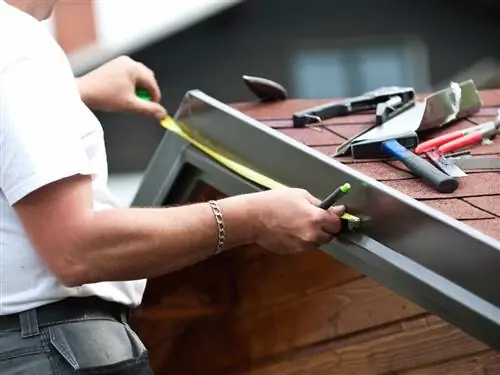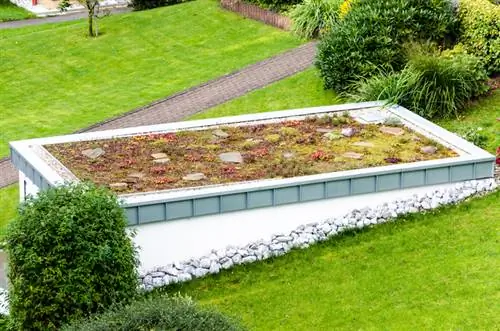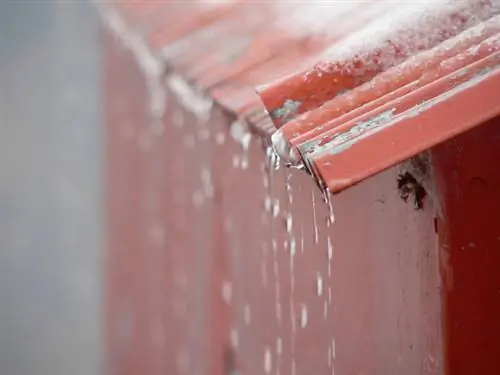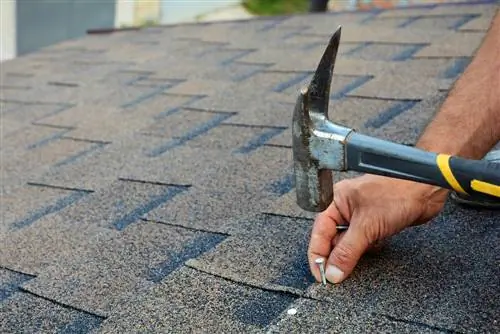- Author admin [email protected].
- Public 2023-12-16 16:46.
- Last modified 2025-01-23 11:21.
In most cases, heavy roof tiles or concrete blocks are not suitable for roofing a garden house. Often the arbor is not made of brick, but made of wood, so the weight of this covering would be far too high. Instead, roofing felt or bitumen shingles are usually used. You can find out how to process these materials correctly and how uncomplicated it is in the following article.
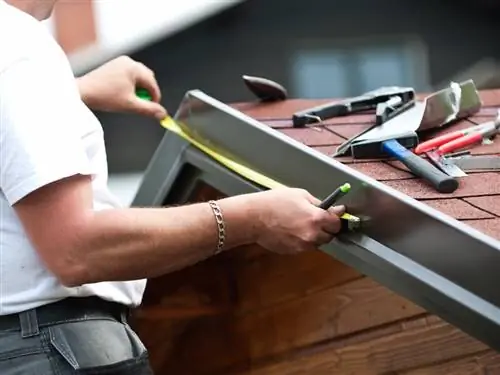
How can I cover the roof of a garden house?
Lighter materials such as roofing felt or bitumen shingles are best suited for roofing a garden house. Roofing felt is inexpensive, easy to install and flexible, while asph alt shingles are more attractive, more robust and also easy to work with.
Roofing felt, the simplest option
Roofing felt is a very inexpensive material. The cardboard soaked with sand, fine gravel or slate chips and bitumen is a reliable moisture barrier. However, heat and other weather influences degrade the roofing felt over the years. Roofing felt also has hardly any insulating properties, so it gets very warm in the garden house in summer and very cold in winter.
Laying roofing felt is very easy:
- Lay the flexible, large-format panels across the roof pitch, overlapping.
- Attach to the roof sheathing with nails or staples.
- If necessary, attach several layers on top of each other for greater stability and durability.
Bitumen shingles: Attractive, robust and easy to process
If you are building a new garden house, it is advisable to use the bitumen shingles that are most commonly used today and are much more durable. These are available in many modern designs and in different shingle shapes such as plain tiles or classic rectangles. This allows you to perfectly match the look of the roof to the surroundings and garden design.
The materials required
- Foredeck track
- Bitumen shingles
- Bitumen shingle adhesive
- Connection plates
- Kappleisten
- Nails
This tool should be present:
- meter stick
- cutter knife
- Hammer
Procedure:
- First, foredeck sheets are laid on wooden panels of the roof parallel to the ridge with an overlap of five centimeters.
- Work very cleanly and use as few nails as possible, this makes it easier to attach the bitumen shingles later.
- If you would like to lay eaves moldings, now is the right time to attach them to the eaves and roof gable.
- Bitumen shingles are installed offset. For the initial row, the shingles are shortened to the end of the leaf incision or by half, depending on the model.
- In the first row start with a full tongue, in the second row with a half tongue, in the third row you cut off a tongue. This means that the butt joints are not on top of each other.
- Drive nails straight. The heads must rest flush on the material so that it is not damaged.
- If the roof pitch is over 60 degrees, you should also fix the shingles with bitumen adhesive.
- The edge areas of the roof are sealed with adhesive, regardless of the slope.
- The ridge is laid in double coverage. The elastic bitumen shingles can be bent over the edge of the roof; the tongue must be as far as the blade cut in the previous shingle.
Tip
A simple and quick way to make the roof of the garden house weatherproof is to cover the roof with corrugated bitumen sheets. For this you should first build a wooden slatted frame onto which the corrugated panels are then nailed.

